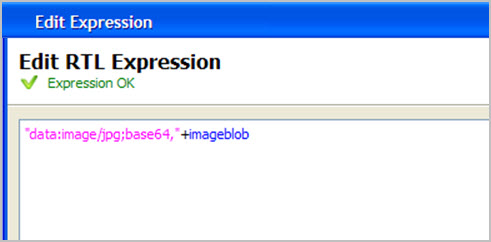Image Box
An Image Box displays images in GIF, JPEG, PNG, BMP, WBMP, PDF, WebP, AVIF and SVG formats.
For information about when to use elements, see Choose report elements.
The Image Box (ImageBox type) is a layout container, found in the Drawables group in the Tool Box view.
The images are cached on a per document basis. The default resolution is the current screen resolution.
The Image Box renders only the first page of a PDF document. If you want to embed the entire PDF, use the PDF Box.
The AVIF image format is only supported on Linux® operating systems with libavif 0.11.1 or above installed.
Properties
Select the object on the Report Design page to display its properties in the Properties view.
These properties are specific to Image Box:
Location, Intended Resolution, Fill
Use the Location property to specify the location of the image to be rendered.
To preserve the aspect ratio, set the value of either X-Size or Y-Size, allowing Report Writer to calculate the corresponding value. If you set both properties, the resulting image appears distorted.
Beginning with version 2.4x, the tile property is replaced by a new property, fill. If you open a document containing the tile property, it is automatically replaced by fill.
Embedding images
To embed a resource, use the "data" URL type, which allows the data to be encoded in the body of the URL text. The full syntax of data URLs is:
data:[MIME-type][;charset=encoding][;base64],dataSee data URI scheme (Wikipedia link) for a complete description of the concept and the syntax.
For our purposes, it is sufficient to support a simplified subset
that omits the charset and assumes that characters are encoded in UTF-8. Image data
is always encoded in base64 (Wikipedia link) while other data such as HTML content is typically "Percent
encoded" (Wikipedia link).
data:/text:file_format;base64,data- file_format is one of "
bmp", "jpg", "jpeg", "gif", "png", "svg", "WebP", "AVIF" or "pdf" - data is the base 64 encoded bitmap data of the image
To automatically construct this URL, click the ... button for the Location property. Choose the file and select the Embed in document check box.

Populating images from blob variables
data:image/jpg;base64,"+imageblobYou can also enter the blob variable name using the Expression Editor for the Location property:

Since a blob variable may contain images of various types, the implementation ignores the image type declared in the formula and looks at the encoded data to determine the image type. This formula also works for blobs of png type.
SVG images
Using SVG images instead of bitmap images can substantially reduce the document size. When providing the SVG content from an FGL variable, use the mime type image/svg so that the url looks something like data:image/svg,... when read from a string variable and data:image/svg;base64,... when read from a BLOB. The currently supported SVG version is "1.2 Tiny" (See http://www.w3.org/TR/SVGTiny12).
Fallback image
A fallback image is displayed if the requested image is not found. To specify a
fallback image, set the GRE_DEFAULT_IMAGE_URL environment variable to the image
URL. The image URL can be a relative URL, which resolves relative to the location of the form design
(4rp) file.